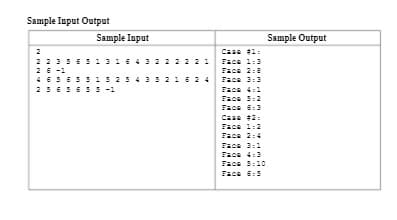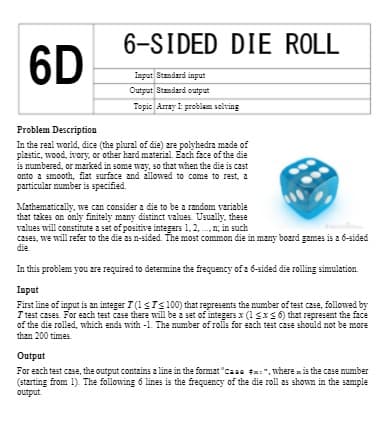6-SIDED DIE ROLL 6D Imput Standard input Output Standard output Topic Array I problem solving Problem Description In the real world, dice (the plural of die) zre polykedra made of plastic, wood, ivory, or other hard material. Each face of the die is mumbered, or mzrked in some way, so that when the die is cast onto a smooth, flat surface and allowed to come to rest, a particular mumber is specified. Mathematically, we can consider a die to be a random veriable thet takes on only firitely many distinct values. Usually, these values will constitute a set of positive itegers 1, 2, .., in such czses, we will refer to the die as n-sided. The most common die in many bozrd games is a 6-sided die In this problem you zre required to detemine the frequency of 2 6-sided die rolling simulation Input First line of input is an integer I (1Is 100) that represents the mumber of test case, followed by I test cases. For each test case there will be a set of integers x (1x6) that represent the face of the die rolled, nhich ends with -1. The mumber of rolls for each test case should not be more than 200 times Output For each test case, the output contains a line in the format "cass tx:", nhere xis the case mumber (starting from 1). The following 6 lines is the frequency of the die roll as shown in the sample output
6-SIDED DIE ROLL 6D Imput Standard input Output Standard output Topic Array I problem solving Problem Description In the real world, dice (the plural of die) zre polykedra made of plastic, wood, ivory, or other hard material. Each face of the die is mumbered, or mzrked in some way, so that when the die is cast onto a smooth, flat surface and allowed to come to rest, a particular mumber is specified. Mathematically, we can consider a die to be a random veriable thet takes on only firitely many distinct values. Usually, these values will constitute a set of positive itegers 1, 2, .., in such czses, we will refer to the die as n-sided. The most common die in many bozrd games is a 6-sided die In this problem you zre required to detemine the frequency of 2 6-sided die rolling simulation Input First line of input is an integer I (1Is 100) that represents the mumber of test case, followed by I test cases. For each test case there will be a set of integers x (1x6) that represent the face of the die rolled, nhich ends with -1. The mumber of rolls for each test case should not be more than 200 times Output For each test case, the output contains a line in the format "cass tx:", nhere xis the case mumber (starting from 1). The following 6 lines is the frequency of the die roll as shown in the sample output
Computer Networking: A Top-Down Approach (7th Edition)
7th Edition
ISBN:9780133594140
Author:James Kurose, Keith Ross
Publisher:James Kurose, Keith Ross
Chapter1: Computer Networks And The Internet
Section: Chapter Questions
Problem R1RQ: What is the difference between a host and an end system? List several different types of end...
Related questions
Question
100%
Write a JAVA program

Transcribed Image Text:Sample Input Output
Sample Iaput
Sample Output
2
Casa #1:
223 5 E51 316 43 2 2 2 221
2E -1
4 ESES515 25 4 3 5 21 624
25E 5655 -1
Face 1:3
Face 2:8
Face 3:3
Face 4:1
Face 5:2
Face 6:3
Caaa #2:
Faca 1:2
Face 2:4
Face 3:1
Face 4:3
Face 5:10
Face f:5

Transcribed Image Text:6-SIDED
DIE ROLL
6D
Imput Standard input
Output Standard output
Topic Array I: problenn solving
Problem Description
In the real world, dice (the plural of die) zre polyhedra made of
plastic, wood, ivory, or other hard material. Each face of the die
is numbered, or marked in some way, so that when the die is cast
onto a smooth, flat surface and allowed to come to rest, a
particular mumber is specified.
Mathematically, we can consider a die to be a random veriable
that takes on only finitely many distinct values. Usually, these
values will constitute a set of positive integers 1, 2, .n; in such
czses, we will refer to the die as n-sided. The most common die in many board games is a 6-sided
die
In this problem you zre required to determine the frequency of 2 6-sided die rolling simulation.
Input
First line of input is an integer T (1<Ts 100) that represents the mumber of test case, followed by
I test cases. For each test case there will be a set of integers x (1sxs 6) that represent the face
of the die rolled, which ends with -1. The number of rolls for each test case should not be more
than 200 times
Output
For each test case, the output contains a line in the format "caae tx:", where x is the case mumber
(starting from 1). The following 6 lines is the frequency of the die roll as shown in the sample
output
Expert Solution
This question has been solved!
Explore an expertly crafted, step-by-step solution for a thorough understanding of key concepts.
Step by step
Solved in 2 steps with 1 images

Recommended textbooks for you

Computer Networking: A Top-Down Approach (7th Edi…
Computer Engineering
ISBN:
9780133594140
Author:
James Kurose, Keith Ross
Publisher:
PEARSON

Computer Organization and Design MIPS Edition, Fi…
Computer Engineering
ISBN:
9780124077263
Author:
David A. Patterson, John L. Hennessy
Publisher:
Elsevier Science

Network+ Guide to Networks (MindTap Course List)
Computer Engineering
ISBN:
9781337569330
Author:
Jill West, Tamara Dean, Jean Andrews
Publisher:
Cengage Learning

Computer Networking: A Top-Down Approach (7th Edi…
Computer Engineering
ISBN:
9780133594140
Author:
James Kurose, Keith Ross
Publisher:
PEARSON

Computer Organization and Design MIPS Edition, Fi…
Computer Engineering
ISBN:
9780124077263
Author:
David A. Patterson, John L. Hennessy
Publisher:
Elsevier Science

Network+ Guide to Networks (MindTap Course List)
Computer Engineering
ISBN:
9781337569330
Author:
Jill West, Tamara Dean, Jean Andrews
Publisher:
Cengage Learning

Concepts of Database Management
Computer Engineering
ISBN:
9781337093422
Author:
Joy L. Starks, Philip J. Pratt, Mary Z. Last
Publisher:
Cengage Learning

Prelude to Programming
Computer Engineering
ISBN:
9780133750423
Author:
VENIT, Stewart
Publisher:
Pearson Education

Sc Business Data Communications and Networking, T…
Computer Engineering
ISBN:
9781119368830
Author:
FITZGERALD
Publisher:
WILEY